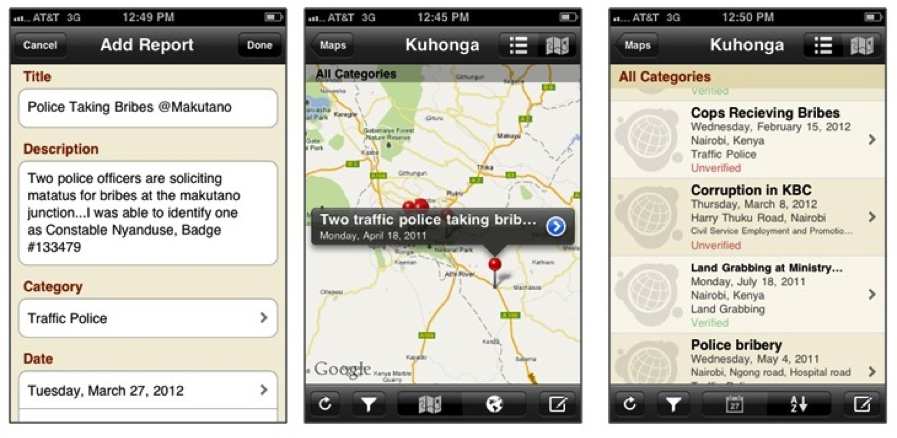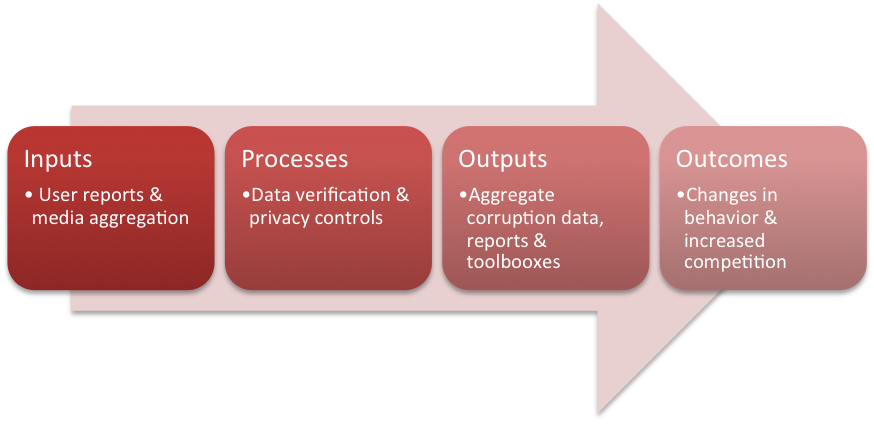We've seen a rise in anti-corruption mapping. In the past few months, we've featured projects from Kosovo, Zimbabwe and even provided global overviews. We've had the honour to join Transparency International at the Anti-Corruption Conference which our community leaders from Morocco and Macedonia presented alongside Nathan Wangusi of Kuhonga. Today we are proud to share Kuhonga's journey, because it is both a global story and a Kenyan story. How can we crush corruption? Can maps and data tools help activists on their mission to affect change? Simply put: Projects like Kuhonga need your support.
 Much has been written about the root causes of poverty in Sub-Saharan Africa. Scholars point to factors as diverse as the lingering effects of colonialism, the tropical disease environment, ongoing public health crises, lack of transportation infrastructure and problems with education. Corruption and governance are often addressed by non-profits working in these areas but only recently has the need to address the problem of corruption separately been recognized.
Kuhonga’s guiding principle is that creating good institutions—institutions free from endemic corruption—is a “first problem.” It is a problem that should be addressed as a separate social issue and that should be addressed first because it underlies and complicates the effects other social problems. We believe that other problems cannot be permanently solved until civil society turns away from an extractive and corrupt model and towards an inclusive public service model.
Increasing cell phone and mobile internet adoption represent an opportunity to combat this “first problem” by magnifying the voice of Kenya’s citizens. Kuhonga hopes to build a safe, effective, and trustworthy private bribery reporting network that creates a robust information map of the current network of corruption. Kuhonga does not take traditional issue advocacy approach to the social problem of corruption. Rather it is focused on turning corruption incident reports and data into useful outputs. At Kuhonga we believe the development of a large database of ground level data about corruption can be used to aid businesses and non-profits in their decision-making processes. By providing data toolboxes and detailed market reports that inform decision-makers Kuhonga hopes to increase individual accountability and create horizontal competition among institutions.
Much has been written about the root causes of poverty in Sub-Saharan Africa. Scholars point to factors as diverse as the lingering effects of colonialism, the tropical disease environment, ongoing public health crises, lack of transportation infrastructure and problems with education. Corruption and governance are often addressed by non-profits working in these areas but only recently has the need to address the problem of corruption separately been recognized.
Kuhonga’s guiding principle is that creating good institutions—institutions free from endemic corruption—is a “first problem.” It is a problem that should be addressed as a separate social issue and that should be addressed first because it underlies and complicates the effects other social problems. We believe that other problems cannot be permanently solved until civil society turns away from an extractive and corrupt model and towards an inclusive public service model.
Increasing cell phone and mobile internet adoption represent an opportunity to combat this “first problem” by magnifying the voice of Kenya’s citizens. Kuhonga hopes to build a safe, effective, and trustworthy private bribery reporting network that creates a robust information map of the current network of corruption. Kuhonga does not take traditional issue advocacy approach to the social problem of corruption. Rather it is focused on turning corruption incident reports and data into useful outputs. At Kuhonga we believe the development of a large database of ground level data about corruption can be used to aid businesses and non-profits in their decision-making processes. By providing data toolboxes and detailed market reports that inform decision-makers Kuhonga hopes to increase individual accountability and create horizontal competition among institutions.

[Guest post by Lewis Kirvan. At Kuhonga I'm the chief operation officer. I'm also a third year law student at the University of Florida and a Policy Analyst (Intern) at the Consumer Financial Protection Bureau. I also have an undergrad degree in African History and lived in Dar es Salaam, TZ for half a year, where I discovered a passion for fighting against corruption. I live in Brooklyn, New York.]Kuhonga is an implementation of Ushahidi that incorporated in January of 2012. The organization is the brainchild of Nathan Wangusi an environmental engineering Ph.D. candidate at the University of Florida. Kuhonga’s essential insight is that crisis mapping and crowd-sourcing of data can be used to tackle the slow-motion crisis of endemic corruption. Social media has proven integral to revolutions in the Middle East and social movements like the Occupy movement in the United States. Kuhonga hopes to extend the success of social media by using Ushahidi’s crowdsourcing capabilities to tackle a different sort of social problem. Rather than facilitating a short term social need, such as organizational support for a social movement or a disaster response team, Kuhonga hopes that a simple and efficient means of reporting corruption can also lead to social change through institutional reform.
 Much has been written about the root causes of poverty in Sub-Saharan Africa. Scholars point to factors as diverse as the lingering effects of colonialism, the tropical disease environment, ongoing public health crises, lack of transportation infrastructure and problems with education. Corruption and governance are often addressed by non-profits working in these areas but only recently has the need to address the problem of corruption separately been recognized.
Kuhonga’s guiding principle is that creating good institutions—institutions free from endemic corruption—is a “first problem.” It is a problem that should be addressed as a separate social issue and that should be addressed first because it underlies and complicates the effects other social problems. We believe that other problems cannot be permanently solved until civil society turns away from an extractive and corrupt model and towards an inclusive public service model.
Increasing cell phone and mobile internet adoption represent an opportunity to combat this “first problem” by magnifying the voice of Kenya’s citizens. Kuhonga hopes to build a safe, effective, and trustworthy private bribery reporting network that creates a robust information map of the current network of corruption. Kuhonga does not take traditional issue advocacy approach to the social problem of corruption. Rather it is focused on turning corruption incident reports and data into useful outputs. At Kuhonga we believe the development of a large database of ground level data about corruption can be used to aid businesses and non-profits in their decision-making processes. By providing data toolboxes and detailed market reports that inform decision-makers Kuhonga hopes to increase individual accountability and create horizontal competition among institutions.
Much has been written about the root causes of poverty in Sub-Saharan Africa. Scholars point to factors as diverse as the lingering effects of colonialism, the tropical disease environment, ongoing public health crises, lack of transportation infrastructure and problems with education. Corruption and governance are often addressed by non-profits working in these areas but only recently has the need to address the problem of corruption separately been recognized.
Kuhonga’s guiding principle is that creating good institutions—institutions free from endemic corruption—is a “first problem.” It is a problem that should be addressed as a separate social issue and that should be addressed first because it underlies and complicates the effects other social problems. We believe that other problems cannot be permanently solved until civil society turns away from an extractive and corrupt model and towards an inclusive public service model.
Increasing cell phone and mobile internet adoption represent an opportunity to combat this “first problem” by magnifying the voice of Kenya’s citizens. Kuhonga hopes to build a safe, effective, and trustworthy private bribery reporting network that creates a robust information map of the current network of corruption. Kuhonga does not take traditional issue advocacy approach to the social problem of corruption. Rather it is focused on turning corruption incident reports and data into useful outputs. At Kuhonga we believe the development of a large database of ground level data about corruption can be used to aid businesses and non-profits in their decision-making processes. By providing data toolboxes and detailed market reports that inform decision-makers Kuhonga hopes to increase individual accountability and create horizontal competition among institutions.
